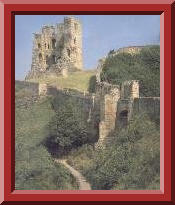
Scarborough
Castle
As we
follow further down the coastline we arrive at the
holiday resort of Scarborough with its mighty Castle
overlooking
a friendly and bustling harbour, it's fishing fleet and
pleasure boats constantly sailing to and fro from this
picturesque town, with its safe sandy beaches
and friendly atmosphere.
Founded in 950 A.D. Scarborough owes it's name to
Thorgils Skarthi the viking raider who decide to make
his
home on this rocky stretch of the North Yorkshire
Coastline.
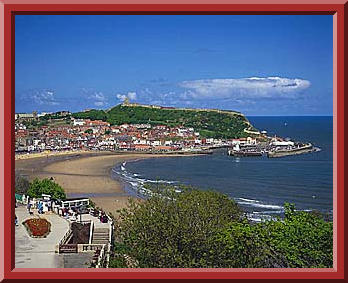
Scarborough,
South Bay
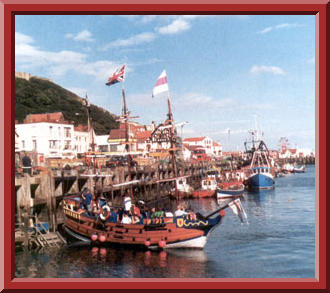
The
"Pirate Ship", Scarborough Harbour

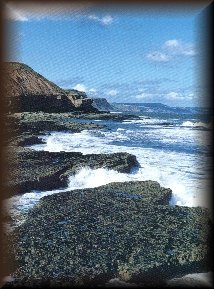
Filey
Brigg
Travelling
down the coast there is the smaller but non the less
attractive holiday town of Filey, sheltered from
the north by the uniquely attractive Filey Brigg, with
it's
plentiful supply of marine life and a variety of
birds
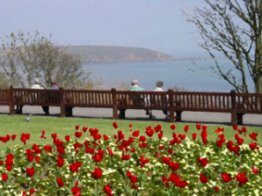
Crescent Gardens,
overlooking the bay at Filey
.
About ten miles from Scarborough, the town of Filey
attracts many visitors and is a very popular holiday
choice to caravanners, there being several large holiday
camps
surrounding this lovely traditional holiday resort with
its
five miles of sandy beach.
A wooded
slope known as The Ravine takes you down to
the beach, sheltered by the gently embracing cliffs.
This is one of the most peaceful and calming views
around the English coast, and elegant resort it is a
lot less crowded than it used to be, but it has looked
after itself well and gets on with
life.
Moving
south we arrive at the holiday resort of
Bridlington.
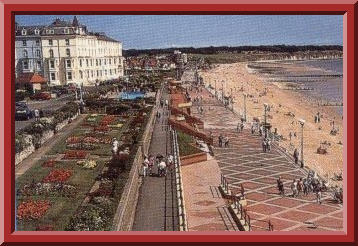
Promenade,
Bridlington
Bridlington
is a medium sized traditional holiday town,
the area is level throughout and there are extensive
sandy beaches either side of the harbour.
It is still a working harbour with the fishing boats
bringing in their catches daily.
This part of the town is compact and the main street is
very close to the promenade.
There is an indoor shopping centre and also a traffic
free area where there is a street market three days a
week.
Both the North and South Beaches have won Tidy Britain
Awards, which means they not only meet the EU bathing
Water
Standards, but have a high standard of cleanliness and
safety.
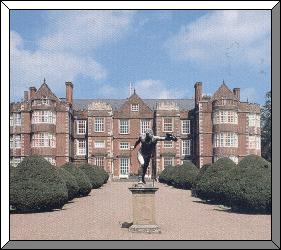
Burton
Agnes Hall, nr Bridlington
Burton
Agnes Hall is a magnificent example of late Elizabethan
architecture, lived in by descendants of the original
family.
This
home is filled with treasures accumulated over four
centuries, from the magnificent carvings commissioned by the
first
owners to the modern French and English paintings of the
Impressionist Schools
collect in recent years.
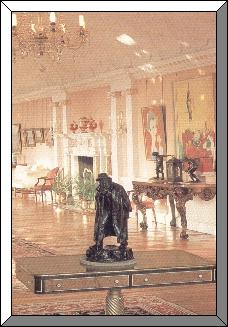
Long
Gallery, Burton Agnes
Hall
The
gardens offer something for everyone, from the ardent
enthusiast who will enjoy identifying over 3,000
different plants, to the young at heart who can seek
to solve the "Riddle of the Maze", get lost in the
jungle,
and play giant board games in the Coloured
Gardens.
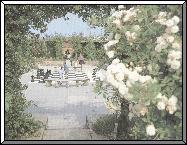
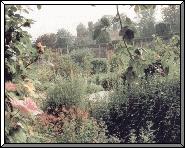
The
wonderfully remodelled gardens have a charm equal to
that of Alice's
Wonderland.

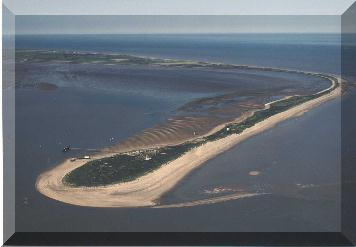
Spurn
Point at low tide
Travelling
further down the coast we arrive at the peninsula of
Spurn Point, a finger of land extending out in to the
Humber Estuary made up of sand and shingle and with a
narrow
road, enclosed on either side by sand dunes covered in
Marram
grass and Seabuckthorn, it leads to the lighthouse
and lifeboat station.
There
has been a lighthouse on Spurn Point since 1427,
the present light was built from 1893 to 1895.
The present lighthouse was built to replace an old
lighthouse
that was positioned just to the south of the present
one.
The only light now at the Point is a flashing green
starboard
light on the very end of the point and the fixed green
lights
marking the end of the Pilots jetty.
Spurn
Point is a very popular place for visitors
who wish to see the variety of birds that visit
the Point, some, such as the Marmor's Warbler
was seen in June 1992 and only the
third recorded in Britain.
And if you fancy a stroll around the Point you can enjoy
the
eight miles to completely walk around this beautiful part
of
the Yorkshire coastline.
Crew
of the Humber Lifeboat
at
April 2001.
"Pride
of the Humber"

Superintendant
Coxswain
Brian
Bevan. MBE

Second
Coxswain Bob
White




Asst.Mechanic:
Chris
Barnes,
Crew:
David
Steenvoorden.
Crew:
Colin
Fisk
Crew:
Dave
Lane

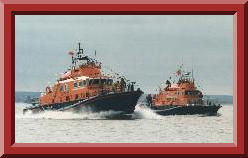
The
old and the new Lifeboats
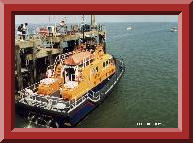
Lifeboat
at refuelling point
The
first lifeboat at Spurn Point was on October 29th 1810,
and was a ten oared boat costing £284.4s.6d the cost
now
of a 'Severn' class lifeboat being
£1,400,000.


Because
of Spurn Point being at the very edge of the coastline
it can be met by very rough seas and the Humber lifeboat
has always been a very busy boat carrying out some of
the
most daring rescues in the history of the Royal National
Lifeboat Institution.
The
present Coxswain, Brian Bevan is the only Coxswain to be
presented with the R.N.L.I Gold, Silver and Bronze
medals in the same awards ceremony.
Photographs
with the kind permission of David
Steenvoorden
dave@spurnpoint.com

Our
travels now take us to the port of Hull
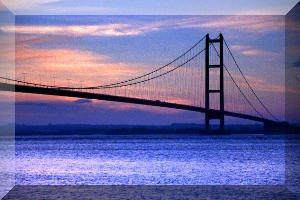
Humber
Bridge, Hull.
With a
population of almost 269,000 Hull is a city
that has everything.
A city famous for its docks, and while the fishing fleet
may have gone forever, business is still booming
in the port, a key European link for the rest
of Britain and Ireland, handling more than
10 million tonnes of cargo yearly and a million
passengers.
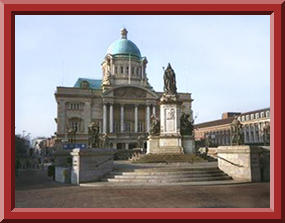
City
Hall, Hull
With its
history stretching back 700 year when Edward I,
realising the strategic importance of this growing port
on the River Humber, conferred upon it
the title of Kings Town upon Hull
(Hull is called today Kingston-upon-Hull)
and granted the town its first Royal charter in
1299.
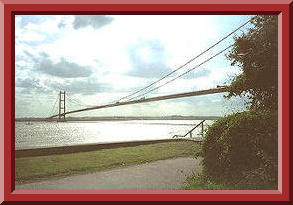
Humber
Bridge
And
today Hull proudly boasts the region's most
famous landmark, the Humber Bridge, the longest
single span bridge in the World.
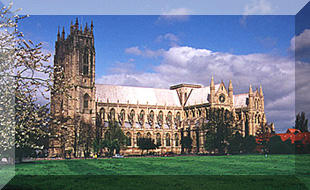
Beverley
Minster.
Approaching
Beverley from the south, the skyline is
dominated by the outline of medieval Beverley Minster,
whose delicate twin towers look from a distance
like a single, stout block. Inside, the richly decorated
family who owned much of the local land.
A curiosity is the 'fridstol', or santuary chair, beside
the altar. This small stone seat dates from
Saxon times. It is thought to have been occupied
by an officer hearing pleas for sanctuary from fugitives
- a practice which continued until sanctuaries were
abolished in 1540.
The minster also contains fine stone and wood carvings,
and an organ dating from 1767.
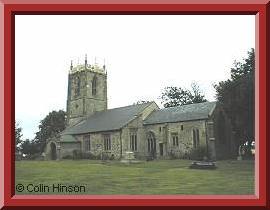
St-Leonards
Church, Beeford.
(photograph
courtesy of Colin Hinson)
The
beautiful 15th Century stone built Church of St-Leonards
watches over this delightful village, a long spread
out village with estates and houses off
the two main streets. The two public houses, The Tiger and
TheYorkshire Rose
caters for the thirsty locals and tourists alike,
and to the hungry the pleasant Fish Shop and Supper Room
feeds the hungry traveller.
The village keep it's gardens neat and tidy and well cared
for.
Beeford
is mentioned in the Domesday Book, from which
we learn that in the reign of Edward the Confessor it
belonged to
Ulf, and Englishman of some note, whose castle is supposed
to
have been at Aldborough.
The value of the village at this time was said to be
twenty pounds, but by the time of the Normans suvey it's
value
was only ten shillings, it's value suffering from the
devastation and ravages perpetrated by the Norman army.
Geographical
and Historical information of Beeford

Returning
North-West, inland from the coast we arrive
at the City of York.
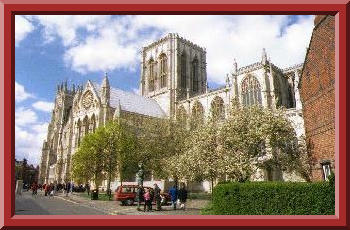
York
Minster.
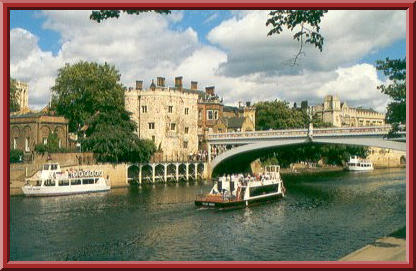
River Ouse looking
towards Lendal Bridge,York.
Identified
so much with the Romans and then Vikings the City is
surrounded by walls that have a Roman base, rebuilt by
the Saxons, destroyed by William the Conqueror and
rebuilt,
first by the Normans and then in the 14th century
in much the same form as today.
York is a thriving modern City, but you'll find constant
reminders of it's Roman, Viking and Medieval past.
An ideal base for visiting the nearby National Parks and
heritage coastline.
If you visit Yorkshire you should always make plans
to visit this City steeped in history, and what makes
it even more enjoyable is that much of York is
pedestrianised,
and a joy to visit- on foot, without difficulty.
For more
information about York
click
here

Travelling
south from York you arrive at Stamford Bridge,
scene of a great battle, it was the last Viking battle
on English soil thus ending the Viking era of English
history.
The Battle of Stamford Bridge was overshadowed in
English history by the Battle of Hastings which occured
just three weeks later in 1066.
When
Edward the Confessor died he left
no direct heir, and the throne of England passed
to Harold of Wessex. Harold's brother Tostig influenced
the legendary Viking warrior, King Harald Harada
of Norway to invade England.
While a
second claimant to the throne of England, William of
Normandy, laboured to launch his own invasion fleet,
the Norwegians sailed by way of the Orkneys and landed
at Riccall, near York with a force probably numbering
10,000 men. Harold had been well aware of the dual
threats to his new kingdom, and he called out his
levies.
These were free men from the shires who owed two months
of military service each year. By September the two
months
were up and rations were low, so Harold reluctantly
released
these irregular troops.
This left him with a trained force of about 3000 mounted
infantry known as house-carls.
When the news came of the Norwegian landing, Harold
quickly marched his men north by the old Roman road
known
as Watling Street.
The Earls
of Northumbria and Mercia, Morcar and Edwin,
advanced their men from York and met Harald Hardrada
at Fulford on September 20.
The experienced Norwegian commander completely
routed the earls, depriving King Harold of valuable
alies for the fatal battle with the Normans which lay
ahead.
The
Norsemen appointed Stamford Bridge as a meeting place
for an exchange of hostages with the city of York.
The confident victors of Fulford were relaxing in the
meadows
surrounding this crossroad 12 miles from York
when to their shock they saw a fresh Saxon army
streaming
up from the South.
Well,
perhaps "fresh" is too strong a word, for Harold had
just
pushed his men an amazing 180 miles in 4 days, and they
were
doubtless exhausted.
The Norsemen were caught completely off-guard; most had
discarded their mail shirts and helmets in the hot sun.
They were soon to pay for their carelessness.
After
fierce hand to hand fighting the Vikings fled, pursued
all the way back to their fleet at Riccall. Only 24 ships
out of
an initial 200 or more made the return to
Norway.
Before
the battle Harold swore that the Norse leader would get
"only seven feet of English soil" for his invasion,
and he kept his vow.
The
Viking King, Harald Hadrada's bones lie somewhere
beneath the fields of Stamford Bridge.

Harewood
House, Harewood,Leeds.
Harewood
is mentioned in the Domesday Book, when it
belonged to three Saxon chieftains. During the Norman
Conquest a Lascelles travelled with
William the Conqueror, and the family have certainly been
in
Yorkshire since 1315 when John de Lascelles lived at
Hinderskelfe, now known as Castle Howard.
In 1738 John Boulter sold Harewood estate to Henry
Lascelles,
and it has been owned by the Lascelles family ever
since.
Edwin Lascelles, Lord Harewood, was born in 1712,
and he commissioned John Carr of York not only to design
a house, but also stables and a 'model' village.
Edwin showed the plans of the development to Robert
Adam,
then an outstanding young architect, but little of
Adam's changes can be seen on the exterior of the house,
although the interior is regarded as one of his
masterpieces.
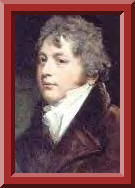
Edward,
Viscount Lascelles.
He chose
Thomas Chippendale, who originated from
nearby Otley, but whose work had become recognised
and who now had a workshop in London, to design and
construct the furniture and furnishings for the whole
house.
Then in 1772 Capability Brown, one of the country's
finest
landscape designers came to Harewood and Lascelles
commissioned him to transform the 1800 acre park in his
naturalistic manner, working closely with nature.
Now home to the present Earl and Countess of Harewood
it contains exquisite architecture and fine art
collections.
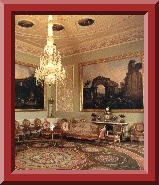
The
Music Room, Harewood House
When
visiting the House you will find a wide variety of
special events, from dog shows to car rallies
to open air concerts the House and grounds abounds with
the widest range of activities, all delivered
to the highest possible standards, a visit to Harewood
House really does provide an outstanding day out
foreveryone.
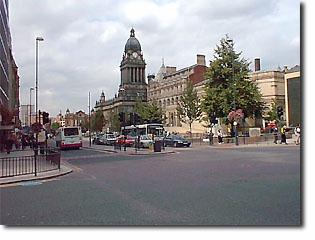
Town
Hall, Leeds.
Travelling
further south we arrive in the capital city of
Yorkshire.
New home to the Royal Armouries, is the second largest
Metropolitan district in the U.K.
A Vibrant, affluent capital, Leeds complements its
economic
with a lively arts, sporting and entertainment scene.
New , shopping malls, hotels, galleries and cafe bars
rub with stylish offices and award-winning
architecture.
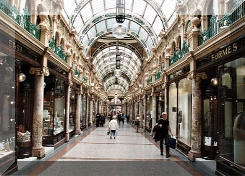
County
Arcade, Briggate, Leeds
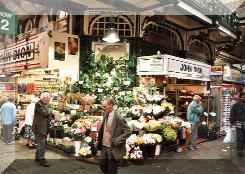
Flower
stall, Kirkgate Market, Leeds
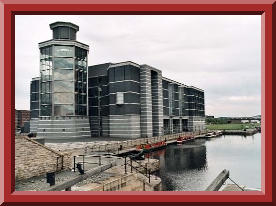
The
Royal Armouries Museum, The Waterfront, Leeds
In it's
new home alongside the River Aire the imposing
new Royal Armouries building houses about 8,000 pieces
of
armour, including 4 personal armours of Henry VIII,
armour from the royal workshops at Greenwich, Stuart
royal armours, medieval armour of the Knights of St John
at Rhodes, munition armour of the 16th and 17th century.
There are about 600 pieces of equestrian equipment,
including horse armours of Henry VIII.
The Royal Armouries
collection has its origins in the
arsenal of the British army preserved at the
Tower of London. Most of the medieval mateiral at the
Tower was disposed of in the modernisation of the army
by
Henry VIII in the 1540s, but from the middle of the
16th century up to the middle of the 19th century
a very large quantity of munition arms and armour was
preserved in the Tower.

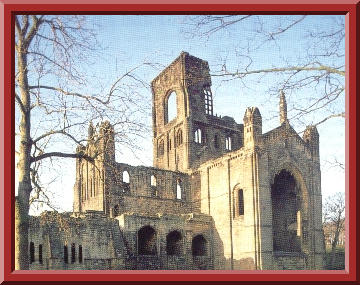
Kirkstall
Abbey, Leeds
Henry de
Lacy, Lord of Pontefract, was seriously ill and
was expected to die. If he survived, Henry promised to
build
a monastery in honour of the Blessed Virgin.
In fact, he did survive and Henry kept his promise, giving
the
Abbot of Fountains Abbey land to build on at
Barnoldswick.
However,
the new site did not prove suitable, and Abbot
Alexander decided that he and his brethren should
move somewhere else.
The site they chose was Kirkstall.
The
imposing facade of Kirkstall Abbey
sits on a grassy site just a couple of miles from the
centre of Leeds, a landmark familiar to both rail
passenger
and towpath walkers. It is one of the finest early
Cistercian
ruins in the British Isles, and was founded in 1152 as a
daughter house of Fountains Abbey.
After the
Dissolution in 1539 it was greatly neglected
and became a fashionably romantic
ruin - visited and painted by Turner and other
artists
It is now
carefully preserved, and the nearby
Abbey House Museum - has a variety of
toys, domestic items and restored streets and
shops.
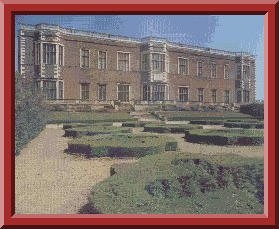
Templenewsam
House, Leeds
The
magnificent Tudor-Jacobean house was the birthplace
of Lord Darnley, husband of Mary Queen of Scots,
and later became the home of the Ingram family, Viscounts
Irwin.
There are over 30 historic interiors (many newly
restored) including a spectacular Picture Gallery,
with superlative paintings, furniture (including the
Chippendale Society collection), silver and ceramics.
The thousand acre Capability Brown park contains
a home farm with rare breeds of animals,
sensational displays of rhododenrons and azaleas (May
and June), national collections of delphiniums and phlox
(July and August, chrysanthemums (September)
and roses (all summer).
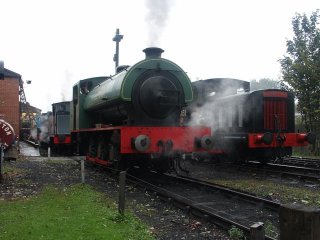
Middleton
Railway
Established
by the first British railway Act of
Parliament in 1758 to carry coal from Middleton
to Leeds the Middleton Railway is the world's oldest
working Railway, and has operated continously since that
time.
It also played host to the first commercially
successful,
revenue earning, steam locomotives designed by
John Blenkinsop and built by Matthew Murray,
which entered service in 1812.
So started
the Leeds locomotive industry some years
before Stephenson's locomotives!
In 1960
the Middleton railway became the first standard
gauge railway to be taken over by a
voluntary organisation.
Today
the Middleton Railway plays host to visitors,
young and old, who enjoy travelling in it's
coaches pulled by magnificent engines on the
world's oldest working railway.
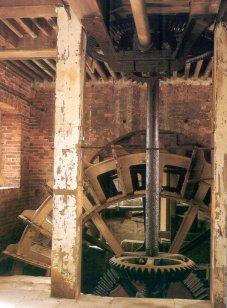
Waterwheel
and bevel gearing, Thwaite Mills Watermill,
Leeds
The
earliest mention of a watermill at Thwaite on the
outskirts of Leeds dates from 1641, when it was probably
used in cloth finishing processes.
In 1872 the Horn family converted Thwaite
mills into stone-crushing mills, installing grinding
machinery.
In the area was a thriving pottery industry and
Thwaite serviced this industry, grinding flint and
chinastone for use as pottery glaze.
The other major product was whiting, produced by grinding
chalk.
Whiting was used in pharmaceuticals, polish and
paint..
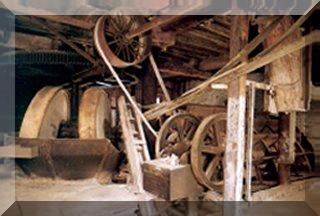
Rock
grinding rollers
During
the depression of 1923 the demand for whiting
fell and the Horn family began using some
of the excess whiting to produce putty.
This then became Thwaite's main product until the
closure in 1976.
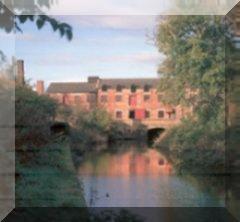
Today
Thwaite Mills Watermill is a living industrial
museum in a waterside setting and is very popular
with education groups and as a venue for family events.
It provides a unique location in which to experience
and learn about a basic but very important, and very
powerful,
industrial technology, which relies on a
simple natural resource.
As fears increase about the exhaustion of fissil fuels
and the safety of nuclear fuel, Thwaite provides a
living
and relevant demonstration of the potential of water as
a
source of power.


Wild
West Yorkshire - Nature Diary
Richard
Bell - Wildlife Illustrator, original artwork and
books.
Wild
West Yorkshire


View
My Guestbook
Sign
My Guestbook

View
my previous Guestbook

Malcolm
 stickerman2@gmail.com
stickerman2@gmail.com
Date
last modified: 29/09/2007
Midi:
"No
other name":
©
from
"Songs of Praise"
written
and produced by
Elton Smith and
Larry Holder
and
used with their
kind permission
